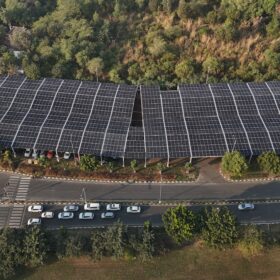From pv magazine Global
Researchers at the Northwestern Polytechnical University in China have fabricated a four-terminal (4T) semi-transparent perovskite-silicon tandem solar cell based on a top perovskite cell integrating an indium oxide (In2O3) sputtering buffer layer (SBL) deposited through a low-cost approach for industrial applications.
SBLs are used in perovskite-silicon tandem devices to prevent bombardment damage during the indium tin oxide (ITO) transparent electrode deposition, protecting the underlying perovskite absorber and the electron transport layer (ETL).
“The In2O3 SBL was fabricated using the e-beam evaporation technique, a solvent-free process compatible with industrial production,” the research’s lead author, Li Can, told pv magazine. “The optical and electrical properties of the In2O3 film exhibited a strong dependence on the deposition rate. Higher deposition rate resulted in In-rich In2O3 films with poor transmittance and increased parasitic absorption. Through optimization of the deposition rate, we achieved stoichiometric In2O3 films, featuring high transmittance and robust protective properties.”
The research team built the top perovskite device with a substrate made of glass and ITO, a self-assembled monolayer (SAM) made of nickel(II) oxide (NiO), the perovskite absorber, an ETL relying on buckminsterfullerene (C60), a bathocuproine (BCP) buffer layer, the In2O3 SBL, and the ITO electrode.
This cell achieved a power conversion efficiency of 20.20%, which the scientists said is close to that of its opaque counterpart, while also showing excellent electrical, optical, and protective properties of the In2O3 layer, with the energy bandgap being 1.68 eV.
“In2O3 films with a thickness of 20 nm effectively protected the underlying perovskite film and ETL from bombardment damage during ITO sputtering,” Can explained. “Various characterizations, including cross-sectional SEM, X-ray diffraction, and steady-state photoluminescence, confirmed this superior protection effect.”
The academics then integrated the top perovskite cell with a silicon bottom cell in a tandem device that achieved an efficiency of 30.04%. This cell was also able to retain around 80% of its initial efficiency after 423 h of continuous light. They claim the cell is one of the highest-performing 4T perovskite-Si tandem solar cells to date.
The description of the device is available in the study “Indium oxide buffer layer for perovskite/Si 4-terminal tandem solar cells with efficiency exceeding 30%,” published in the Journal of Energy Chemistry.
“Our work expands the limited selection of available SBL materials for p-i-n structured ST-PSCs and introduced a low-cost deposition approach for industrial applications,” Can concluded. “This work demonstrates significant potential for accelerating commercialization and widespread application of perovskite photovoltaics.”
This content is protected by copyright and may not be reused. If you want to cooperate with us and would like to reuse some of our content, please contact: editors@pv-magazine.com.









By submitting this form you agree to pv magazine using your data for the purposes of publishing your comment.
Your personal data will only be disclosed or otherwise transmitted to third parties for the purposes of spam filtering or if this is necessary for technical maintenance of the website. Any other transfer to third parties will not take place unless this is justified on the basis of applicable data protection regulations or if pv magazine is legally obliged to do so.
You may revoke this consent at any time with effect for the future, in which case your personal data will be deleted immediately. Otherwise, your data will be deleted if pv magazine has processed your request or the purpose of data storage is fulfilled.
Further information on data privacy can be found in our Data Protection Policy.